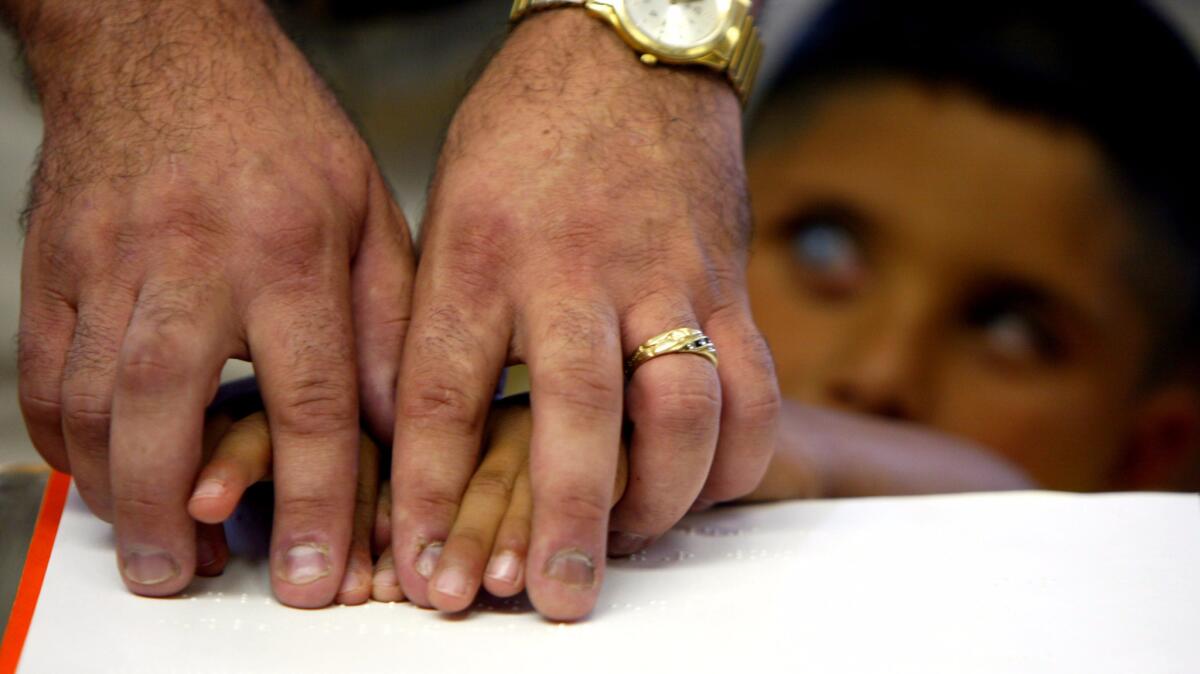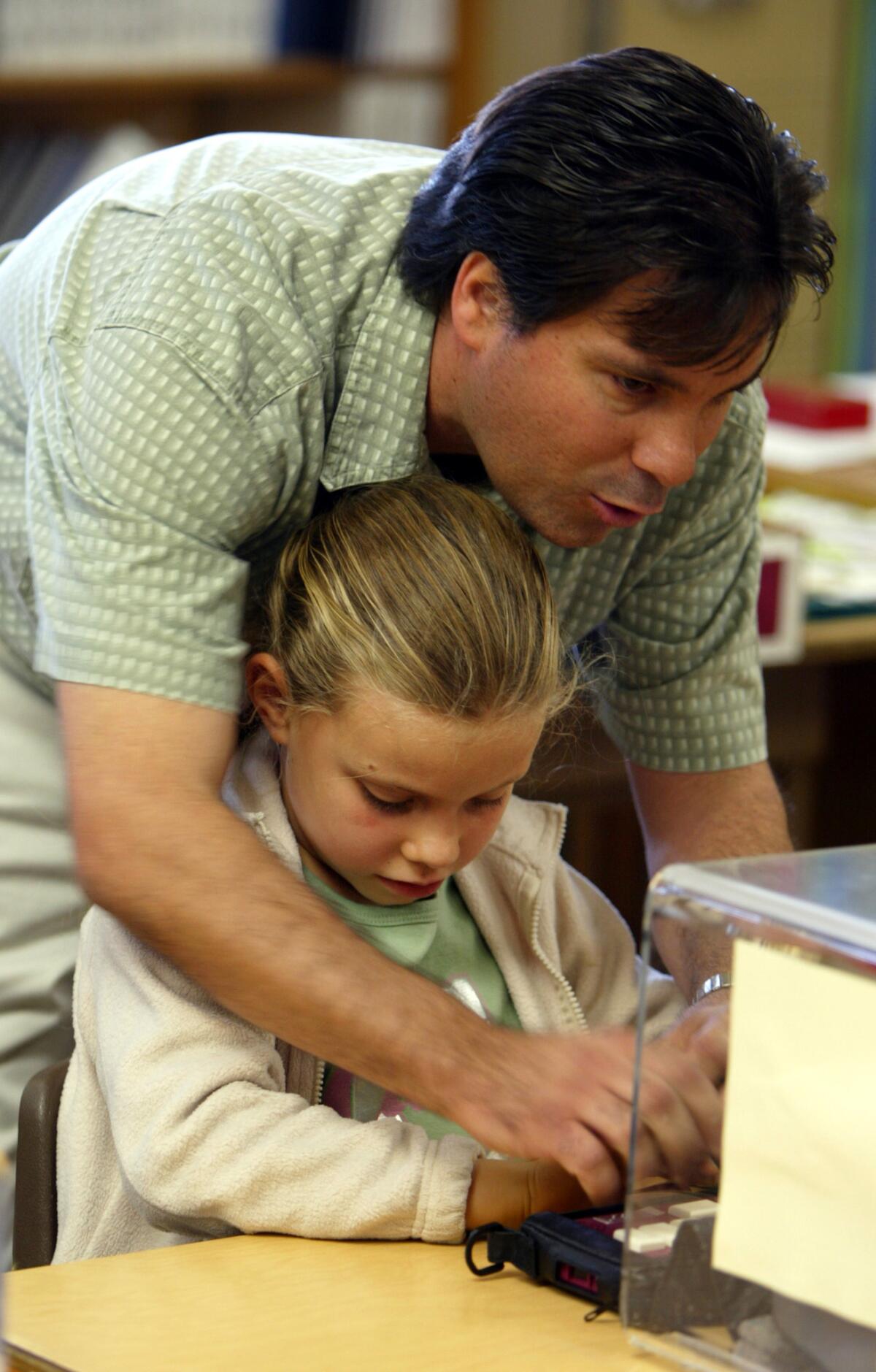From the Archives: When teaching visually impaired, being one of them has advantages

Story time in the library was over for Keith Christian's small class of blind and nearly blind students at Clara Barton Elementary School in Anaheim. Tapping their canes against table legs and the door frame, the four young students headed back to the classroom.
En route, Christian suggested a bathroom stop. Marina Patten, 7, making her way alone toward the girls' room, paused and asked for directions.
"You're in the breezeway, next to the drinking fountain," the teacher said from afar. "Almost there."
READ: How to live blind and bold — a Braille teacher's lesson plan for life »
It seemed like an ordinary exchange, except that Christian, too, is all but blind.
Christian, 38, is one of only a very few visually impaired teachers serving blind students in California public schools. Everyday tasks such as finding a book or navigating a computer program can pose challenges, but education experts and parents say teachers such as Christian are invaluable -- not only for their classroom talents, but for their connections with students.
I hope I am helping them see that even with their blindness, they are just regular people who can do for themselves.
— Keith Christian
"It's an adventure. You have to plan for everything," Christian said. "I hope I am helping them see that even with their blindness, they are just regular people who can do for themselves. I am nothing special, but I am very determined, and I think I can model that for them."
Visually impaired children from the Anaheim City School District and surrounding districts enroll in Christian's class. One of the few teachers in Orange County specially trained to work with them, he has six pupils in grades one through five.
The varying ages pose a challenge, as Christian must tailor lessons to grade levels. So, too, does the fact that some students suffer from other disabilities that can accompany blindness.
Regardless, Christian runs his classes much like any other teacher, drilling students on spelling and pronunciation and walking through addition and subtraction problems. A cardboard box full of silkworms is the latest science experiment.
Christian also teaches Braille. He moves from student to student, wrapping his arms around them from behind and placing their hands on the textured pages, helping them sound out sentences and comprehend equations with their fingers.

As someone who had to fend for himself until learning Braille in college, Christian pushes his students to master it. "This looks sloppy, Ricardo," he said sternly as he ran his fingers across a math problem a student had typed on a Braille machine. "I can't read it. Please redo it."
A 1998 study found that legally blind students who learned Braille at the same time sighted students learned to read achieved, in high school, literacy rates similar to their sighted classmates. But students who learned Braille later or were taught to visually read using magnification devices suffered low rates of literacy.
Christian, a technology buff, has opened the world of computers to his students. They are aided by specialized software that reads aloud the names of documents and keyboards that translate text into Braille. "I'm doing it!" hooted Dominic Montelongo, 11, as he found the right keys during a typing lesson.
Christian smiled. "You're rocking."
The teacher must sometimes rely on a sighted assistant to help find misplaced textbooks or keep a student focused.
Lessons in Christian's class include skills for independent living. Every trip from the classroom is a chance to improve on walking with a cane. Students are responsible for feeding an aquarium full of fish and watering a garden. Shoelaces must be tied and trash thrown away. Jam sessions sometimes break out on instruments in the classroom.
"Being blind himself, he knows what these kids need," said teaching assistant Jennifer Jennings. "He thinks about things that we would never consider. Before he started, for example, we would unpack the students' backpacks for them, but he makes them do it. He wants them to be able to do everything on their own."
Living with blindness, Christian said, allows him to relate to his students. "We talk about my blindness and I can tell them how I felt when I walked into something -- that I was embarrassed but held my head up high and kept going," he said.
Parents echoed the sentiment. Marina's mother, Tina Patten, said she was doubtful when Christian called to introduce himself and told her of his blindness. Then Patten saw him in action. "I was so impressed," she said. "I asked him, 'Are you sure you are really blind?'"
See the most-read stories this hour »
Christian was born with a degenerative eye disease that has progressively robbed him of his sight. The Orange County native can distinguish little more than dark shadows in bright light. He studied for two years at Cal State Fullerton and worked in customer service at a bank, but said he felt the pull to give blind students opportunities he never had. Christian then earned a teaching credential from Cal State L.A. and taught for seven years in Los Angeles before starting this year in Anaheim.
With a nationwide shortage of teachers for the blind, Christian's students are especially fortunate to have him, said Stuart Wittenstein, superintendent of the California School for the Blind in Fremont. Wittenstein said districts typically share teachers and ask them to travel between schools, which is difficult for teachers such as Christian. As a result, only 2% to 3% of teachers for the blind are visually impaired themselves.
Christian and Wittenstein said the ultimate goal is to prepare blind students to join sighted students in mainstream classrooms. They cautioned, however, against premature pressure by parents and teachers to mainstream blind students before they have a strong grasp of Braille. At Clara Barton, two blind students attend mostly mainstream classes and call on Christian as needed. Christian's four other students join sighted peers each day for recess and some class time.
Christian doesn't accept his students' blindness as an excuse to underachieve.
"It has taken a while to get them to approach problems and say, 'Yes, I can do this.' I want them to believe they can do anything," Christian said.
